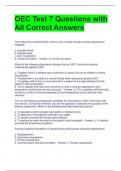Exam (elaborations)
OEC Test 7 Questions with All Correct Answers
- Course
- Institution
OEC Test 7 Questions with All Correct Answers The finding that a patient's skin is warm, pink, and dry during a primary assessment suggests: a. possible shock. b. possible fever. c. poor oxygenation. d. normal circulation. - Answer- d. normal circulation. Which of the following stateme...
[Show more]



